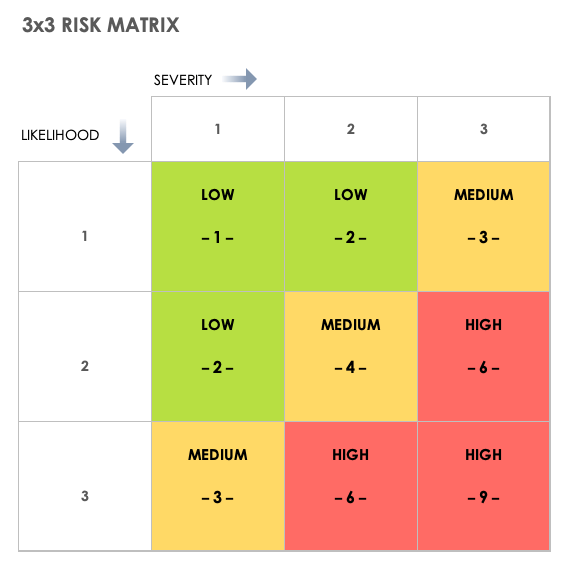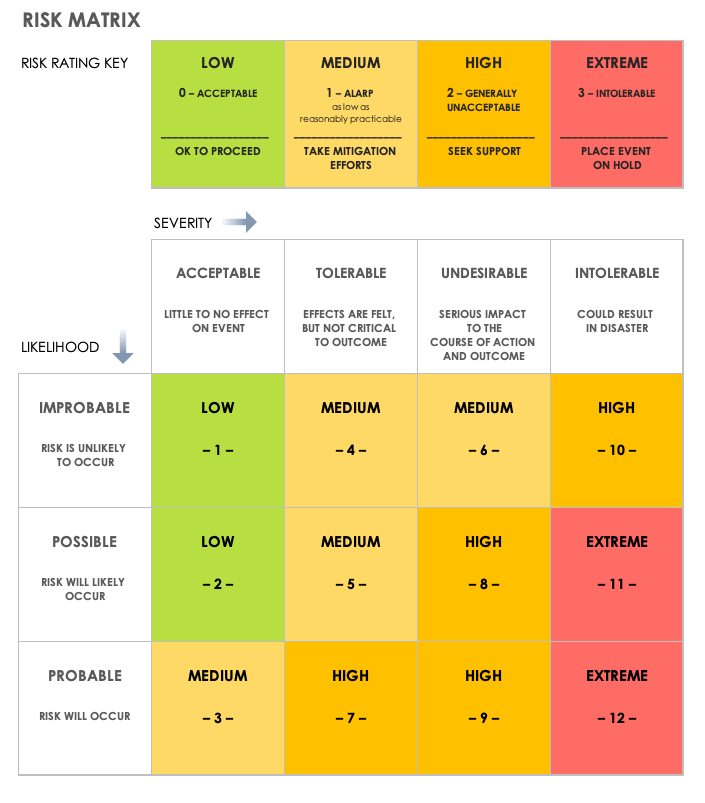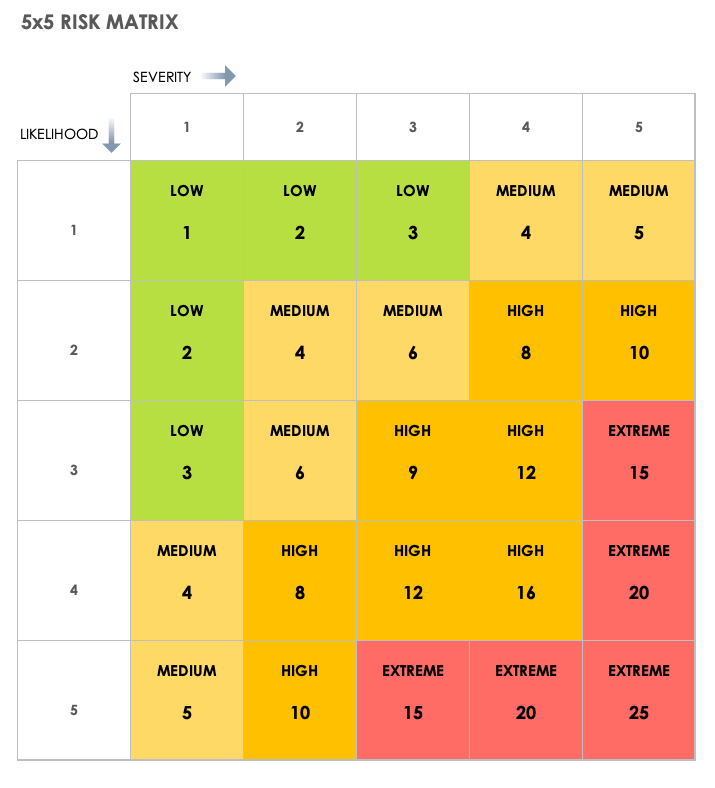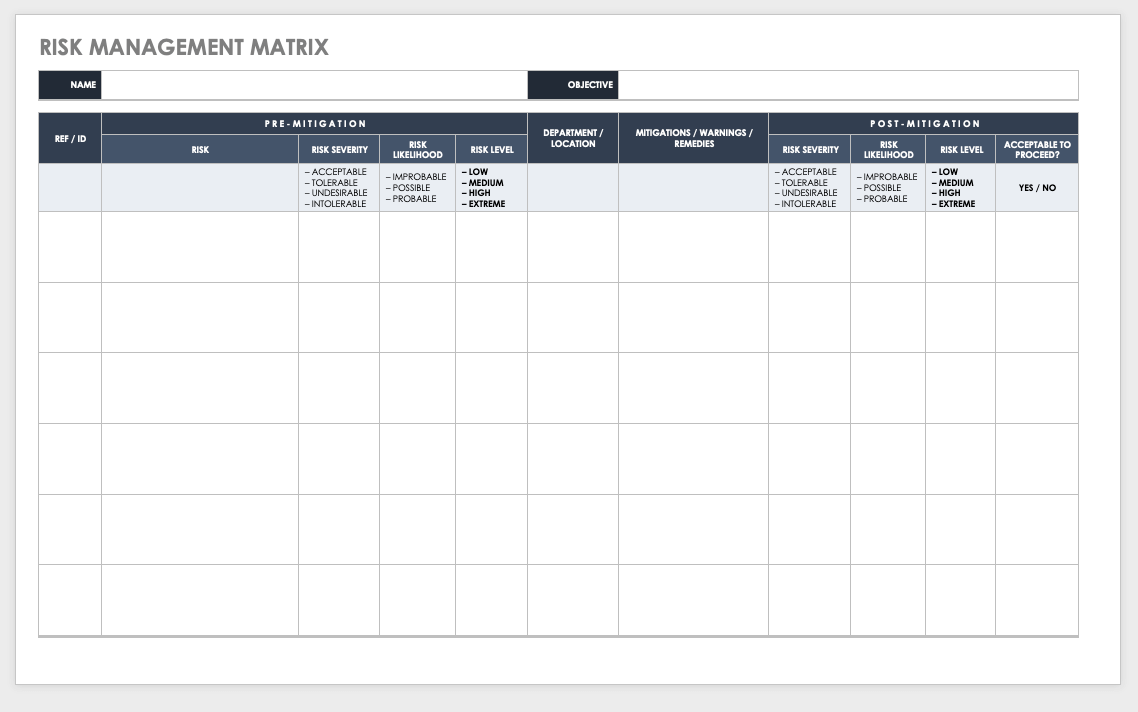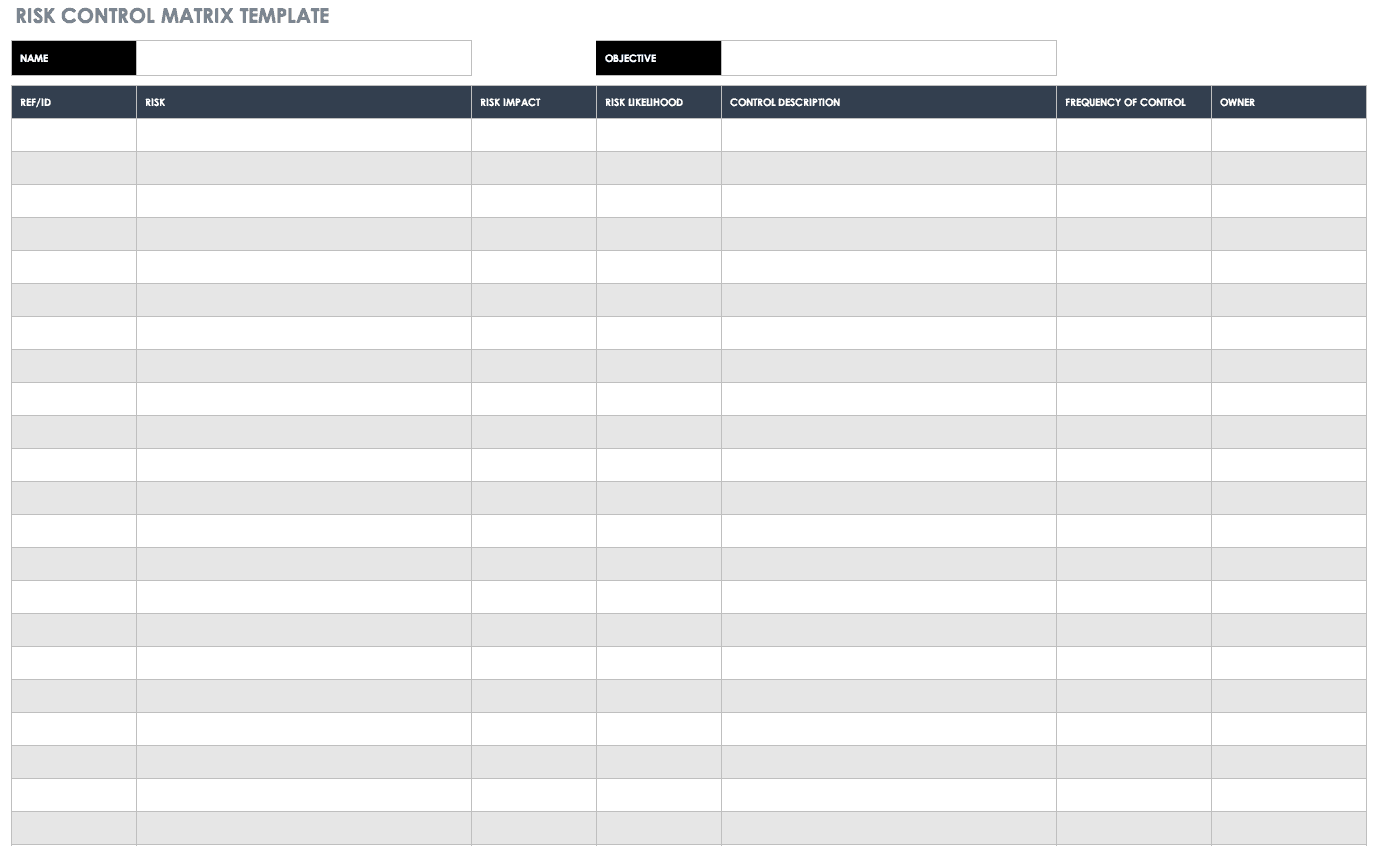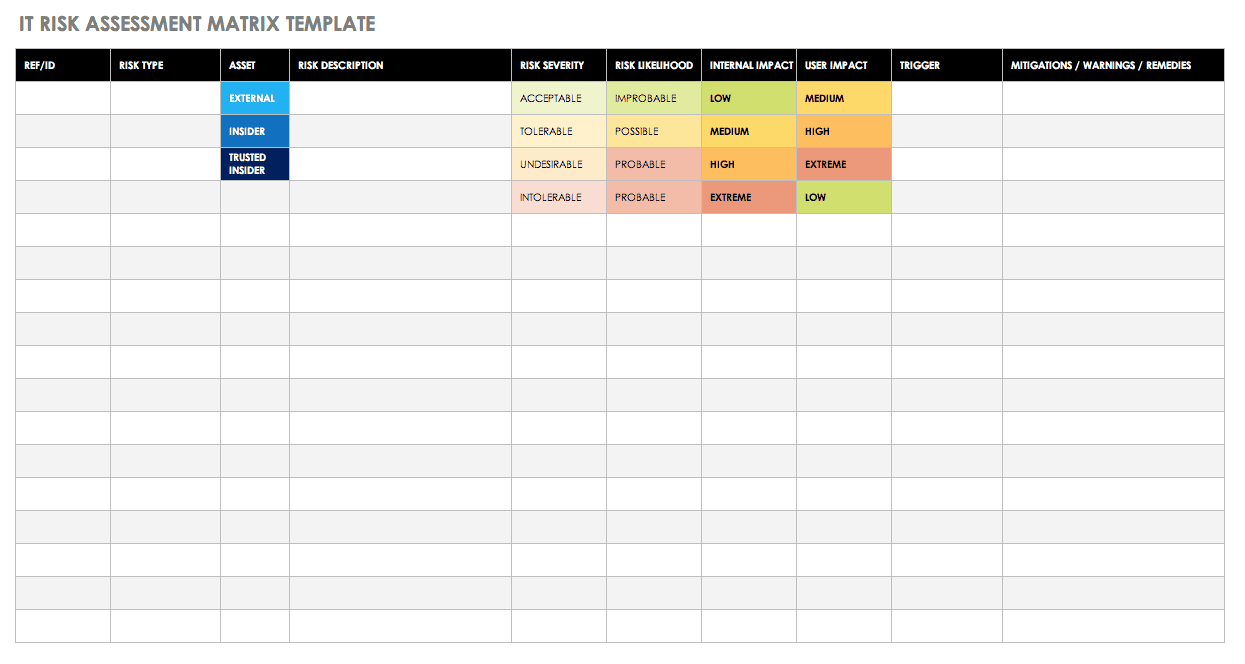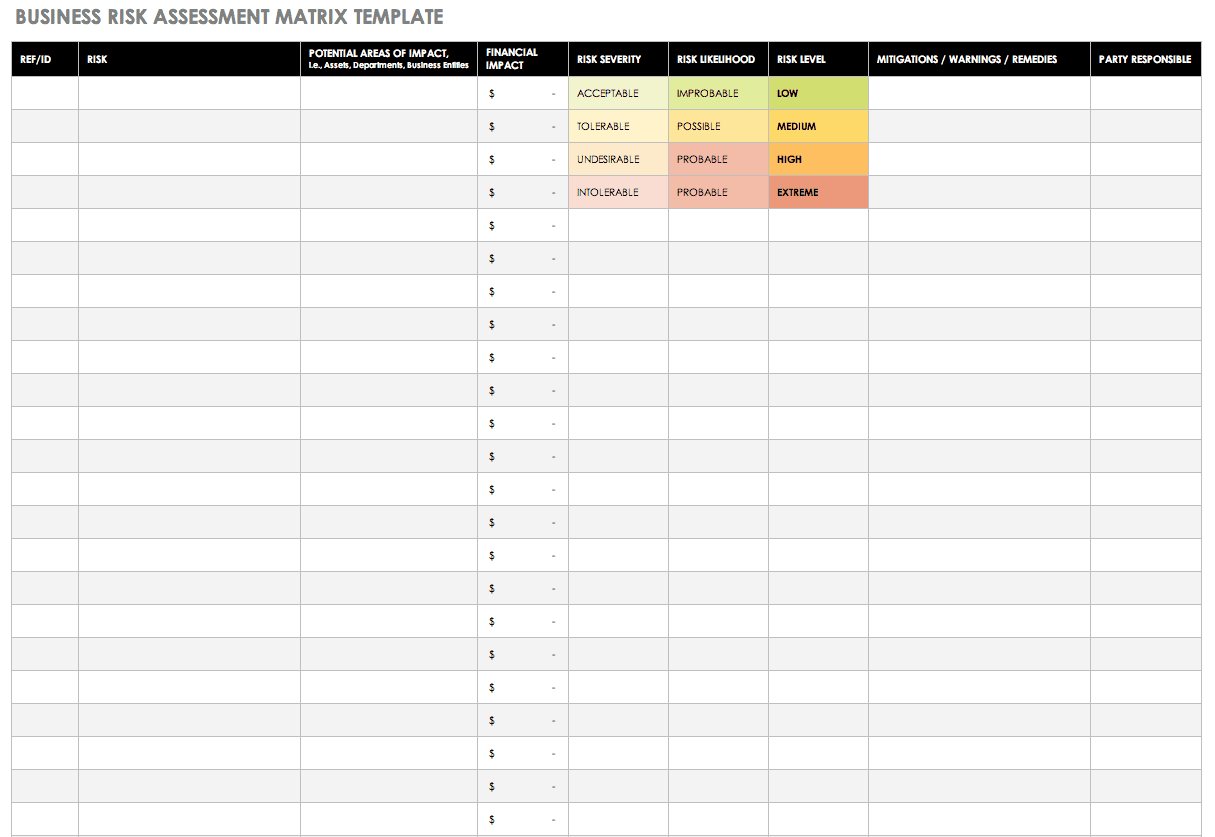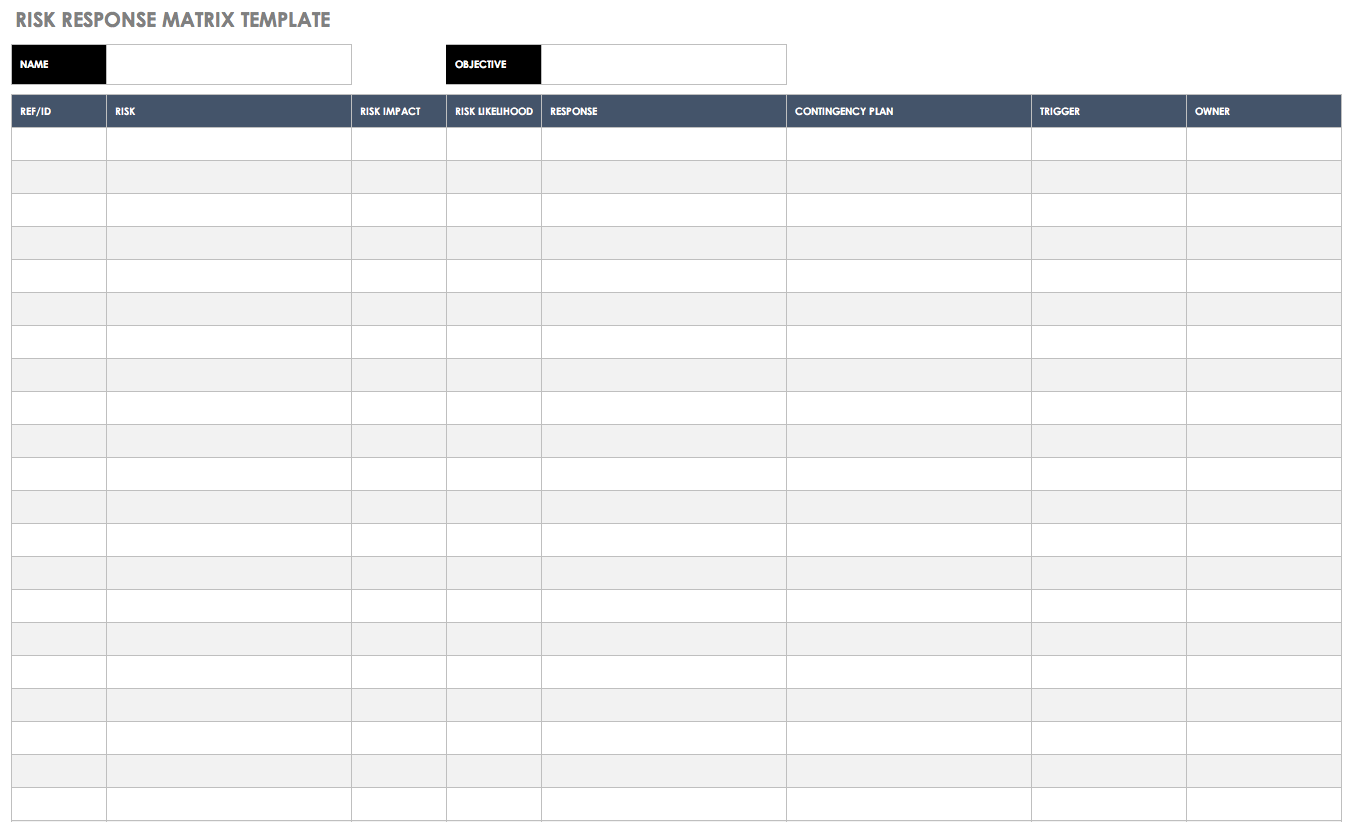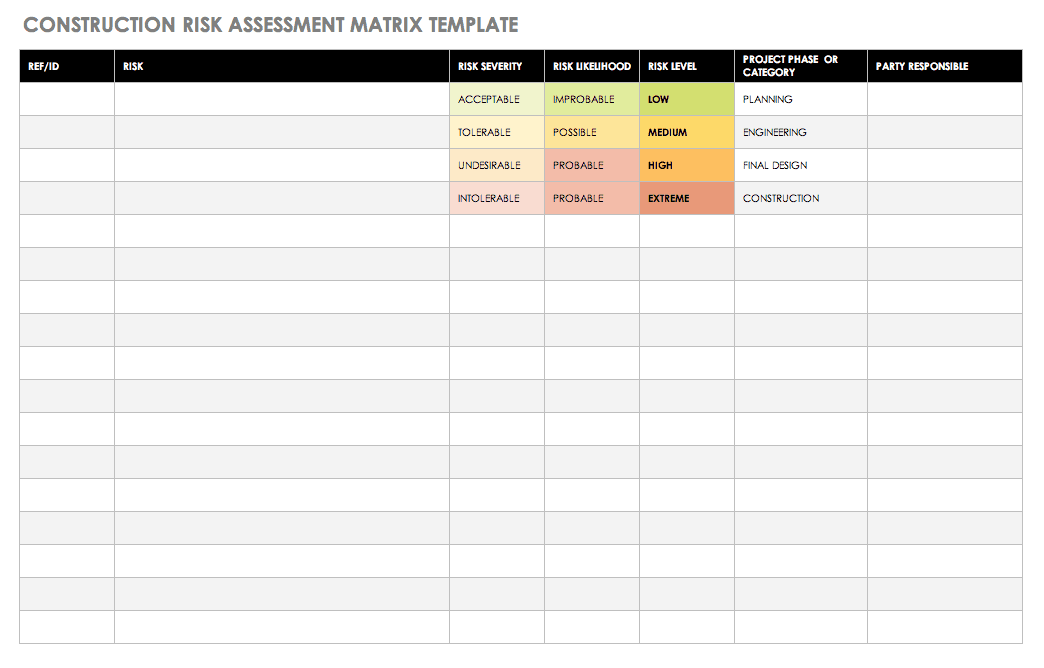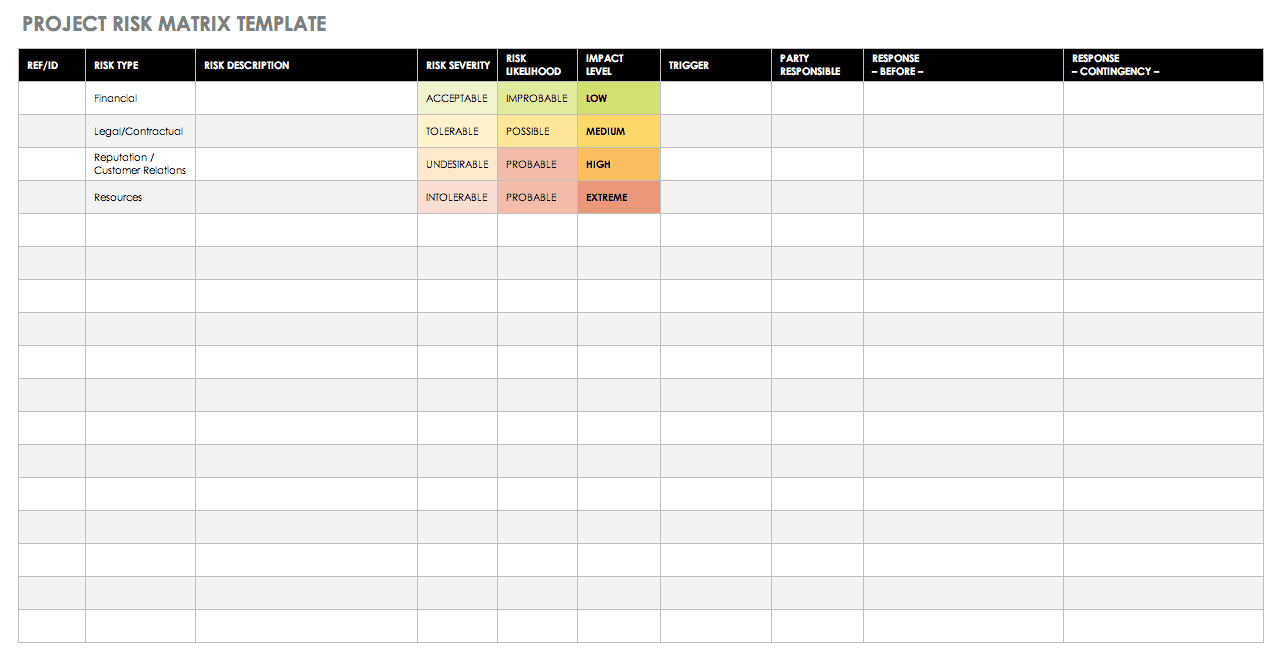Free Risk Matrix Templates
Risk matrices, also called risk severity matrices, can help you determine the priority of risks. Once you determine the severity and likelihood of your risks, list them in the order to be addressed. Color coding helps visualize risk rankings, and you can also designate zones in your matrix as generally acceptable (GA), as low as reasonably possible (ALARP), and generally unacceptable (GU) to create an at-a-glance view of which risks to prioritize. Read more about these zones below.
3x3 Risk Matrix Template
Download 3x3 Risk Matrix Template
This 3x3 risk matrix template is ideal for teams and organizations that prefer simplicity. The template provides three levels to code both the severity and likelihood of each risk: low, medium, and high (which are assigned values of one, two, and three, respectively). After determining the values for the severity and likelihood, use the grid to determine the risks that need to be addressed first.
3x4 Risk Matrix Template
Download 3x4 Risk Assessment Matrix Template Below
Excel | Word | PDF | Smartsheet
This 3x4 risk matrix template uses non-numeric scales for likelihood and severity; after selecting the options for each parameter, use the values in the matrix to determine the level of severity for each risk.
5x5 Risk Matrix Template
Download 5x5 Risk Matrix Template
The 5x5 matrix template provides additional scaling options; this template is ideal for organizations that need more granular insight into each risk. After determining the values for severity and likelihood, use the grid to determine the priority of the risks.
Risk Management Matrix Template
Download Risk Management Matrix Template
Excel | Word | PDF | Smartsheet
Use this risk management matrix to identify risks and determine when they require mitigation. This template allows you to rate risk impact and likelihood both before and after mitigation, and note the actions that will be taken to manage the impact of risks.
Risk Control Matrix
Download Risk Control Matrix Template
Excel | Word | PDF | Smartsheet
This type of risk matrix is helpful for organizations or projects that regularly encounter a high degree of risk. It reflects risks and their impact, as well as the automated and manual controls available to help limit the resulting losses. You can use this risk control matrix later to create a risk response plan, and can customize it to fit the needs of your project or organization.
IT Risk Assessment Matrix Template
Download Risk Response Matrix Template
IT involves a variety of unique risks and in today’s data-driven environment, the consequences are often severe. Threats to data, systems, and networks originate from a variety of sources, ranging from natural disasters to hardware failures. However, in IT, many risks are human-related, such as external threats (hackers or terrorists), insider threats (ex-employees who have login credentials), or trusted insiders (current employees who gain improper access).
This IT risk analysis matrix allows you to plan responses to the most catastrophic risks, contain moderate risks, and monitor less severe ones. Factor in data and system requirements, the time it will take to recover data/system functioning, and the minimum staff and equipment needed to conduct business in the meantime.
Business Risk Assessment Matrix Template
Download Risk Response Matrix Template
This risk matrix example shows you how to anticipate risks your company may experience, so you can prepare to address them before they impact your bottom line.
Use this business risk assessment matrix to list potential risks, the assets, departments, or business entities that will be affected, the likelihood of each risk, available prevention or mitigation actions, and more.
Depending on your business, the impact rating may relate to financial loss, operational difficulties, a drop in customers, or some other measure.
For additional information and resources on how to assess risk pertaining to third-parties your organization does business with, visit "Vendor Assessment and Evaluation Simplified," and "Free Vendor Risk Assessment Templates."
Risk Response Matrix Template
Download Risk Response Matrix Template
In addition to analyzing risks themselves, this risk response matrix allows you to outline a plan for respondse. With this risk matrix template for Excel, you can list risks, rate their likelihood and impact, and note the response to each (e.g., “reduce” or “eliminate”). You can also describe the contingency plan for responding to the risk, the event that will trigger the response, and the party that will handle the response.
This risk matrix is especially useful for high-risk industries, organizations, or projects. It offers an at-a-glance view of not only the impact of risks, but also the triggers to look for and the proper plan for addressing risks that occur.
Construction Risk Assessment Matrix Template
Download Risk Response Matrix Template
There are many different types of risks common to construction projects, including on-the-job risks (worker injury or accident), financial risks, project risks, natural risks, and competitive risks.
By using a construction risk assessment matrix, you can anticipate common risks, and gauge the impact they will have on your project. You can also note whether the contractor, owner, or designer is responsible for addressing them. With this risk assessment matrix example, you can stay within schedule and budget, and ultimately protect your profit margins.
Project Risk Matrix Template
Download Risk Response Matrix Template
Use this risk assessment matrix to conduct a qualitative risk analysis of risk probability, and gauge how severe the impact of each risk would be on project scope, schedule, budget, and completion. This risk matrix template allows you to rate risks both before and after a response, along with events that could trigger the risk, the person or entity in charge of responding, and the response plan.
What Is a Risk Matrix?
A risk matrix is a chart that plots the severity of an event occurring on one axis, and the probability of it occurring on the other. You can also format the matrix as a table, where the risk likelihood and impact are columns, and the risks are listed in rows. By visualizing existing and potential risks in this way, you can assess their impact, and also identify which ones are highest-priority. From there, you can create a plan for responding to the risks that need the most attention.
A risk matrix chart is a simple snapshot of the information found in risk assessment forms, and is often part of the risk management process. These forms are more complex, and involve identifying risks, gathering background data, calculating their likelihood and severity, and outlining risk prevention and management strategies.
Risk management is the process by which organizations discover, analyze, and address risk to meet goals, keep projects on track, and stick to budgets and timelines. It involves five stages: planning, identification, analysis, response, and monitoring/control. Creating a risk matrix is often one of the first steps in the risk management process, and frequently occurs in the analysis phase (after the risk assessment forms have been created).
How to Use a Risk Matrix Template
Also known as a risk management matrix, risk rating matrix, or risk analysis matrix, a risk matrix template focuses on two aspects:
- Severity: The impact of a risk and the negative consequences that would result.
- Likelihood: The probability of the risk occurring.
To place a risk in the risk matrix, assign a rating to its severity and likelihood. Then plot it in the appropriate position in your chart, or denote the rating in your table. The typical classifications used are as follows:
Severity:
- Insignificant: Risks that bring no real negative consequences, or pose no significant threat to the organization or project.
- Minor: Risks that have a small potential for negative consequences, but will not significantly impact overall success.
- Moderate: Risks that could potentially bring negative consequences, posing a moderate threat to the project or organization.
- Critical: Risks with substantial negative consequences that will seriously impact the success of the organization or project.
- Catastrophic: Risks with extreme negative consequences that could cause the entire project to fail or severely impact daily operations of the organization. These are the highest-priority risks to address.
Likelihood:
- Unlikely: Extremely rare risks, with almost no probability of occurring.
- Seldom: Risks that are relatively uncommon, but have a small chance of manifesting.
- Occasional: Risks that are more typical, with about a 50/50 chance of taking place.
- Likely: Risks that are highly likely to occur.
- Definite: Risks that are almost certain to manifest. Address these risks first.
Classifying and Prioritizing Risk
After you’ve placed each risk in the matrix, you can give it an overall risk ranking. Risks that have severe negative consequences and are highly likely to occur receive the highest rank; risks with both low impact and low likelihood receive the lowest rank. Risk rankings combine impact and likelihood ratings to help you identify which risks pose the greatest overall threats (and therefore are the top priority to address).
Some organizations use a numeric scale to assign more specific risk rankings. However, most rankings fall into a few broad categories, which are often color-coded:
- Low: The consequences of the risk are minor, and it is unlikely to occur. These types of risks are generally ignored, and often color-coded green.
- Medium: Somewhat likely to occur, these risks come with slightly more serious consequences. If possible, take steps to prevent medium risks from occurring, but remember that they are not high-priority and should not significantly affect organization or project success. These risks are often color-coded yellow.
- High: These are serious risks that both have significant consequences, and are likely to occur. Prioritize and respond to these risks in the near term. They are often color-coded orange.
- Extreme: Catastrophic risks that have severe consequences and are highly likely to occur. Extreme risks are the highest priority. You should respond to them immediately, as they can threaten the success of the organization or project. They are often color-coded red.
Once you’ve ranked your risks, you can make a risk response plan to prevent or address those that are “high” or “extreme.” You may not need to respond to risks ranked “low” or “medium” before work begins.
Risk Template Matrix Zones
Many organizations get an even clearer picture of risk by dividing the matrices into zones:
- Generally Acceptable (GA): In the area of the chart ranked “low,” risks have little impact and/or are unlikely to occur. Risks in this region don’t pose an immediate threat to the project or organization, and some can even be ignored.
- As Low As Reasonably Possible (ALARP): This is a zone of acceptable risk, encompassing the “low” and “medium” ranking areas. Risks falling within this region of the matrix are tolerable or not significantly damaging; work can proceed without addressing these risks being immediately.
- Generally Unacceptable (GU): This is the area of the chart where risk is “high” or “extreme.” Risks in this region are quite damaging, highly likely to occur, and would threaten the project or organization. They are highest-priority, and you must address them immediately.
Validation and Risk Response
To ensure you’ve chosen the right risk matrix chart and completed it correctly, validate it with a real-world scenario. After selecting your template, fill it in with examples of risks your organization encounters. After you’ve used the matrix to quantify the severity and likelihood of risks, it’s up to your team to come up with a risk response plan for those ranked “GU.”
Depending on your industry or organization size, you may have additional resources for risk assessment and response. For example, the U.S. Occupational Safety and Health Administration (OSHA) has specific matrices workers can use when responding to natural disasters: The Hazard Exposure and Risk Assessment Matrix helps workers and employers assess risks and operate more effectively in areas impacted by hurricanes.
Of course, a risk rating matrix is simply a tool to help guide decision-making. The risk management team should always carefully analyze both the matrices and the risks themselves before deciding how to prevent, mitigate, or respond to a current or potential risk. Risk matrices are commonly used in project management to examine how risks might affect project scope, schedule, and cost. But they’re also used in industries from construction to IT. Our free risk matrix examples contain a variety of types for different industries, so you can find one that best fits your needs.
The Importance of Risk Assessments in Healthcare Organizations
There are many potential threats affecting healthcare organizations, such as clinical testing errors, hospital facilities issues, security breaches of protected health information (PHI), and more. Healthcare organizations are under strict regulations when it comes to risk and compliance, meaning establishing a risk assessment and determining where those risks exist are extremely important for the business, both legally and functionally.
Creating a plan to handle risk can help to identify the most severe threats, assess their likelihood, and determine how to mitigate them. In addition, risk assessments can identify the location of all PHI and establish a targeted risk response to safeguard confidential information.
Healthcare risk assessments must be comprehensive, accessible across authorized members of the organization, and sufficient in the way it identifies and addresses all potential threats to processes and information. To ensure that all healthcare data, information, and procedures are effectively audited for possible risks, you need a tool that enables you to quickly identify, mitigate, and prevent risks from coming to fruition, while also offering real-time visibility into all potential threats.
Smartsheet is a work execution platform that empowers healthcare companies to view and update risks across the organization with real-time dashboards, so you can make the best decisions at the right time. Highlight identified risks, update likelihood and severity, and oversee how they are being addressed to keep your team on the same page, all while ensuring utmost security and protection of PHI. Set sharing settings within dashboards to ensure that only authorized users have access to confidential information, so your organization remains compliant with HIPAA regulations.
Interested in learning more about how Smartsheet can help you accurately and securely document healthcare processes and maximize your efforts? Discover Smartsheet for Healthcare.
Make Better Decisions, Faster with Smartsheet Dashboards
Empower your people to go above and beyond with a flexible platform designed to match the needs of your team — and adapt as those needs change.
The Smartsheet platform makes it easy to plan, capture, manage, and report on work from anywhere, helping your team be more effective and get more done. Report on key metrics and get real-time visibility into work as it happens with roll-up reports, dashboards, and automated workflows built to keep your team connected and informed.
When teams have clarity into the work getting done, there’s no telling how much more they can accomplish in the same amount of time. Try Smartsheet for free, today.
